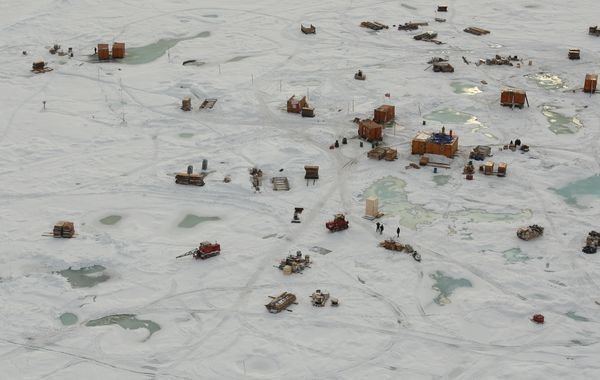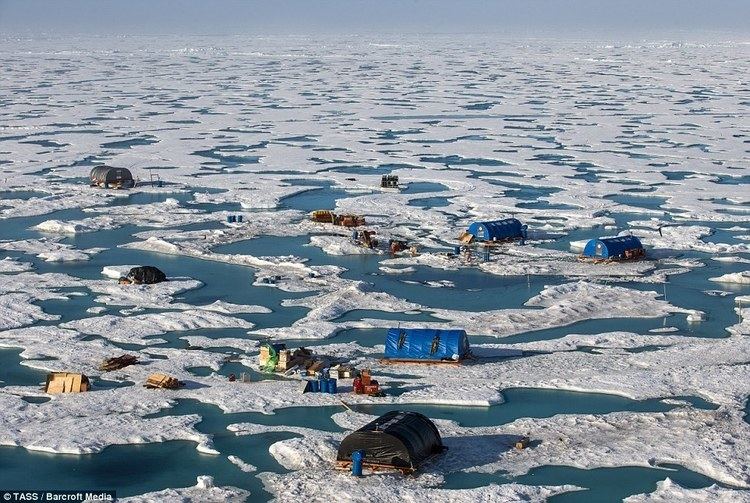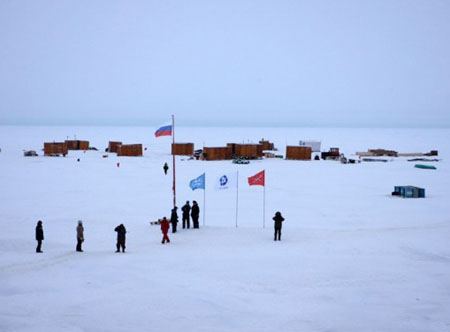 | ||
Soviet and Russian manned drifting ice stations are research stations built on the ice of the high latitudes of the Arctic Ocean. They are important contributors to exploration of the Arctic. The stations are named North Pole (NP; Russian: Северный полюс, Severny polyus, СП), followed by an ordinal number: "North Pole-1,"... etc.
Contents

Overview

"NP" drift stations carry out the program of complex year-round research in the fields of oceanology, ice studies, meteorology, aerology, geophysics, hydrochemistry, hydrophysics, and marine biology. On average, an "NP" station is the host for 600 to 650 ocean depth measurements, 3500 to 3900 complex meteorology measurements, 1200 to 1300 temperature measurements and sea water probes for chemical analysis, 600 to 650 research balloon launches. Magnetic, ionosphere, ice and other observations are also carried out there. Regular measurements of the ice flow coordinates provide the data on the direction and speed of its drift.

The modern "NP" drifting ice station resembles a small settlement with housing for polar explorers and special buildings for the scientific equipment. Usually an "NP" station begins operations in April and continues for two or three years until the ice floe reaches the Greenland Sea. Polar explorers are substituted yearly. Since 1937 some 800 people were drifting at "NP" stations.
There are two groups of "NP" stations:
All "NP" stations are organized by the Russian (former Soviet) Arctic and Antarctic Research Institute (AARI).
History

An idea to use the drift ice for the exploration of nature in the high latitudes of the Arctic Ocean belongs to Fridtjof Nansen, who fulfilled it on Fram between 1893 and 1896. The first stations to use drift ice as means of scientific exploration of the Arctic originated in the Soviet Union in 1937, when the first such station in the world, North Pole-1, started operations.
North Pole-1 was established on May 21, 1937 some 20 km from the North Pole by the expedition into the high latitudes Sever-1, led by Otto Schmidt. "NP-1" operated for 9 months, during which the ice floe travelled 2,850 kilometres. On February 19, 1938, Soviet ice breakers Taimyr and Murman took off four polar explorers from the station, who immediately became famous in the USSR and were awarded titles Hero of the Soviet Union: hydrobiologist Pyotr Shirshov, geophysicist Yevgeny Fyodorov, radioman Ernst Krenkel and their leader Ivan Papanin.
Since 1954 Soviet "NP" stations worked continuously, with one to three such stations operating simultaneously each year. The total distance drifted between 1937 and 1973 was over 80,000 kilometres. North Pole-22 is particularly notable for its record drift, lasting nine years. On June 28, 1972 the ice floe with North Pole-19 passed over the North Pole for the first time ever.
During such long-term observations by "NP" stations, a lot of important discoveries in physical geography were made, valuable conclusions on regularities and the connection between processes in the polar region of the Earth's hydrosphere and atmosphere were obtained. Some of the most important discoveries were finding the deep-water Lomonosov Ridge, which crosses the Arctic Ocean, other large features of the ocean bottom's relief, the discovery of two systems of the drift (circular and "wash-out"), the fact of cyclones' active penetration into the Central Arctic.
The last Soviet "NP" station, North Pole-31, was closed in July 1991.
In the post-Soviet era, Russian exploration of the Arctic by drifting ice stations was suspended for twelve years. The year 2003 was notable for Russia's return into the Arctic. As of 2006, three "NP" stations had carried out scientific measurements and research since then: "NP-32" through "NP-34". The latter was closed on May 25, 2006.
"NP-35" started operations on September 21, 2007 at the point 81°26′N 103°30′E, when flags of Russia and Saint Petersburg were raised there. 22 scientists, led by A.A.Visnevsky are working on the ice floe. Establishment of the station was the third stage of the Arktika 2007 expedition. An appropriate ice floe was searched for from Akademik Fedorov research vessel, accompanied by nuclear icebreaker Russia, using MI-8 helicopters, for a week, until an ice floe with an area of 16 square kilometres was found. The ice has since shrunk significantly, however, and the station is now being abandoned ahead of schedule.
